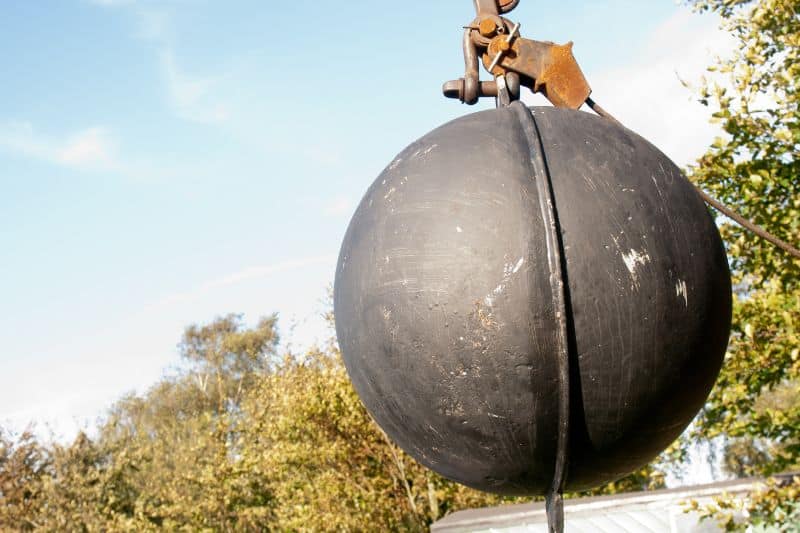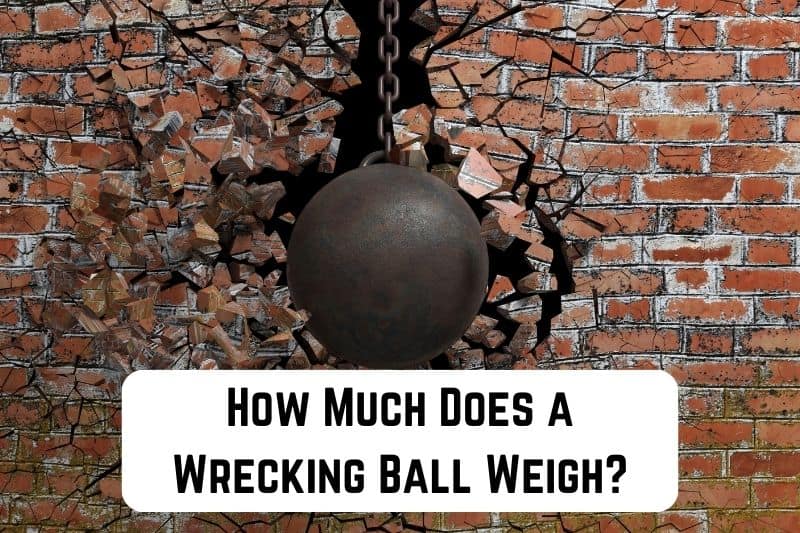Wrecking balls have always fascinated me, especially when I see them in action, taking down massive structures in seconds. But have you ever wondered how much a wrecking ball weigh? Well, I was curious too, and I thought it would be interesting to find out and share my findings with you.
To better understand the factors that influence the weight of a wrecking ball and its effectiveness in demolition projects, it’s important to take a closer look at their design, materials, and the forces they exert. So, join me as we explore the world of wrecking balls and discover what lies behind their massive impact.
Some of the smaller wrecking balls weigh as little as 1,000 pounds, while the larger ones can weigh up to 12,000 pounds or even more. The industry often determines the size and weight of a wrecking ball based on the type of demolition project it will be used for.
Read: How Much Does a Can of Coke Weigh? (Answered)

Basics of Wrecking Balls
When I first started learning about wrecking balls, I was amazed by these massive spherical tools and their powerful impact on demolishing structures.
Generally, a wrecking ball is solid steel and can weigh between 1,000 and 12,000 pounds. The ball’s weight varies depending on the size and type of building and the manufacturer’s specifications.
Wrecking balls have a long history of use in the construction and demolition industry. One of the earliest examples of a wrecking ball can be traced back to ancient Rome, where I discovered they would use a stone block attached to a crane for similar demolition purposes. However, it wasn’t until the 20th century that modern wrecker ball entered the demolition scene.
Now, you might be curious about what makes a wrecking ball so effective. The secret to its destruction capabilities is in the physics behind it. I’ve learned that as a wrecking ball is lifted high into the air and released, it gains potential energy.
Once the ball swings down and hits its target, it transforms into kinetic energy, resulting in a forceful impact that can break through walls and bring down buildings.
Regarding materials, most wrecking balls are made of forged steel, which is ideal for enduring the repeated impacts required in the demolition process. The ball is usually attached to a steel cable that connects to a crane, allowing me to control its movements and target specific areas of the structure I wish to demolish.
To sum it up, wrecking balls are highly effective tools used in the demolition industry, and their weight plays a crucial role in their success. By understanding the basics of wrecking balls, including their weight range, history, physics, and materials, I now better appreciate this mighty tool and its impact on transforming our urban landscapes.
Dynamics of Weight
I want to discuss the dynamics of a wrecking ball’s weight and its importance to the demolition process. Wrecking balls come in various sizes, and, consequently, their weights can vary significantly.
The weight of a wrecking ball primarily depends on its size and the material used in its construction. Typically, they are made of solid steel; however, some wrecking balls can be constructed from other materials like iron, depending on factors like demolition requirements and budget constraints. On average, wrecking balls weigh between 1,000 to 12,000 pounds (454 to 5,443 kilograms).
The heavier a wrecking ball, the more effective it becomes in demolition operations. A heavier ball generates more force upon impact, resulting in a faster and more efficient demolition process. However, considering other factors, such as the crane’s lifting capacity and the building structure’s reinforcement, is essential.
In addition to weight, momentum is crucial in an effective wrecking ball demolition. Momentum, which is determined by mass and velocity, directly affects the force a wrecking ball can generate:
Momentum = Mass × Velocity
Increasing the velocity can enhance the momentum without adding extra weight to the wrecking ball. This ensures compatibility with the crane’s lifting capacity and allows for effective demolition with a lighter wrecking ball.

Weight of Different Wrecking Ball Sizes
I have gathered some information on various wrecking ball sizes and their respective weights. It’s important to note that the weight of a wrecking ball can significantly impact its performance and effectiveness in demolition work.
Wrecking balls come in different sizes, usually from 1,000 to 12,000 pounds (about 450 kg to 5,400 kg). The size and weight of a wrecking ball depend on the specific demolition project requirements. For smaller projects, a lighter wrecking ball would be suitable, while larger projects would require a heavier one.
- 1,000-pound wrecking ball (approx. 450 kg): These lightweight wrecking balls are suitable for small-scale demolition work, such as breaking through brick or cinder block walls.
- 5,000-pound wrecking ball (approx. 2,268 kg): This medium-sized wrecking ball can be used for more significant structural demolition tasks, including breaking concrete slabs and removing steel-reinforced structures.
- 12,000-pound wrecking ball (approximately 5,443 kg): A 12,000-pound wrecking ball is the heaviest and is reserved for the most demanding demolition projects, typically involving large concrete or steel structures requiring immense force.
Measurement Factors
When it comes to calculating the weight of a wrecking ball, several factors need to be taken into consideration.
First and foremost, the materials used in its construction play a significant role in determining its weight. Most wrecking balls are made of cast iron or steel, which are both heavy and dense. Knowing the composition of the wrecking ball helps in estimating its weight accurately.
Another variable to consider is the wrecking ball’s size. Generally, the larger the ball, the heavier it will be. Wrecking balls come in various sizes, ranging from as small as 1000 pounds to as heavy as 12,000 pounds. The chosen size often depends on the strength of the structure that needs to be demolished and the type of crane used.
Additionally, the density of the materials used in the wrecking ball’s construction also influences its weight. Solid wrecking balls typically weigh more, whereas hollow ones are lighter. Some wrecking balls may also contain internal weights, adding to their overall mass.
Lastly, the state of the wrecking ball can affect its weight too. Wrecking balls used extensively may be chipped or worn, reducing weight compared to a brand-new one.
Types of Wrecking Balls
Various types of wrecking balls can be found in the demolition industry, which differ based on their material and their size and shape. In this section, I will cover the influence of material and the effects of size and shape on wrecking balls.
Material Influence
The material used for a wrecking ball greatly impacts its weight and durability. Typically, wrecking balls are made of forged steel or cast iron. Forged steel is known for its superior strength and ability to withstand immense pressure.
Cast iron, on the other hand, is less durable and lighter than forged steel. While both materials serve different purposes, choosing the right one is essential based on the intended demolition project.
- Forged Steel: Suitable for heavy-duty demolition work
- Cast Iron: More appropriate for lighter demolition tasks
Size and Shape Effects
The size and shape of a wrecking ball affect not only its weight but also its efficiency in demolition. Wrecking balls come in various sizes, ranging from a few hundred pounds to several tons.
The larger the wrecking ball, the more powerful its impact. However, it’s also essential to consider the working space and the type of structure to be demolished before selecting a specific size.
Read: How Much Does a Flute Weigh? (400 – 800 grams)
As for shape, wrecking balls can be found in three primary forms: spherical, cylindrical, and pear-shaped. Each shape has its advantages and drawbacks:
- Spherical: Offers a good balance between weight and surface area, providing maximum impact.
- Cylindrical: Allows for more concentrated force, making it suitable for breaking through concrete walls.
- Pear-shaped: Designed for precise demolition work, providing better control and maneuverability.
Frequently Asked Questions
How heavy are typical wrecking balls in demolition?
When it comes to demolition, wrecking balls vary in weight. Typically, they range from 1,000 to 12,000 pounds (450 to 5,400 kilograms). The weight of a wrecking ball depends on factors such as the size of the structure being demolished and the specific requirements of the project.
What factors affect the weight of a wrecking ball?
Several factors can affect the weight of a wrecking ball, including its size, material composition, and design. Bigger wrecking balls are generally made for demolishing larger or more robust structures, while smaller ones are used for lighter work. The material used to construct the wrecking ball will also significantly impact its weight.
How does wrecking ball weight influence its effectiveness?
The weight of a wrecking ball plays a crucial role in its effectiveness. A heavier wrecking ball can generate more force upon impact, which is essential for breaking through thick walls and sturdy materials. On the other hand, lighter wrecking balls may be more suitable for less resistant structures or delicate demolitions.
What materials contribute to wrecking ball weight?
Wrecking balls are typically made from dense materials to provide the necessary weight to demolish structures effectively. The most common material used for wrecking balls is steel, due to its high density and durability. Steel wrecking balls are often filled with lead or other heavy metals to increase their weight and effectiveness.







